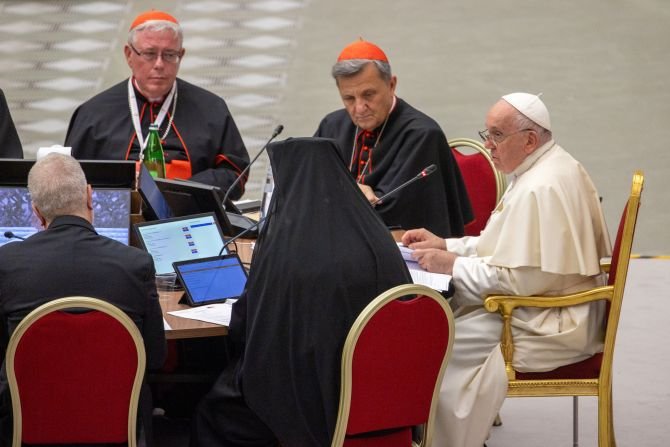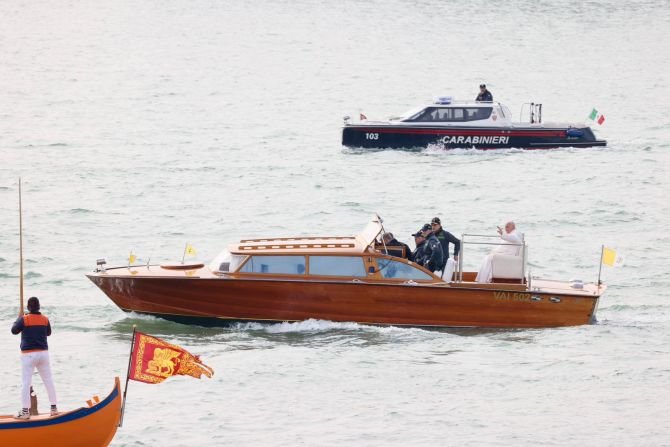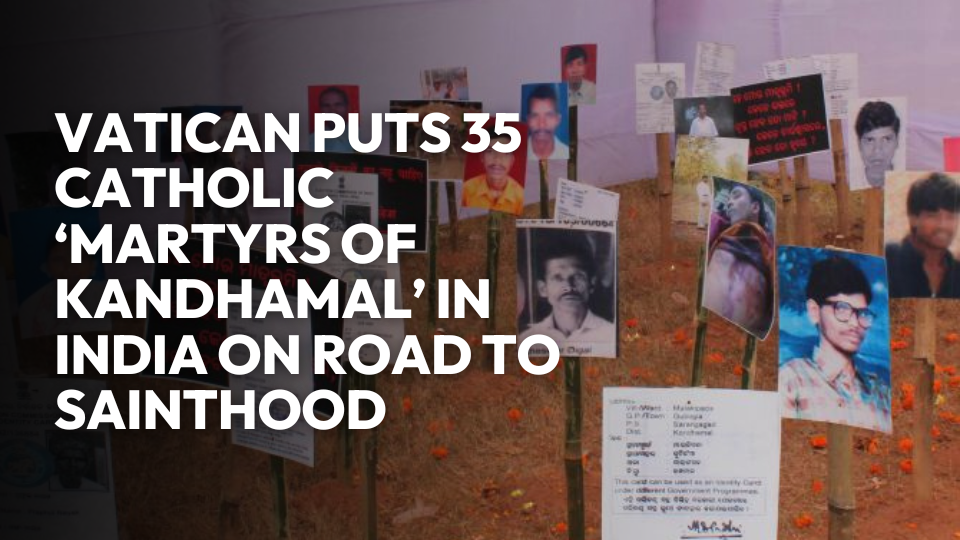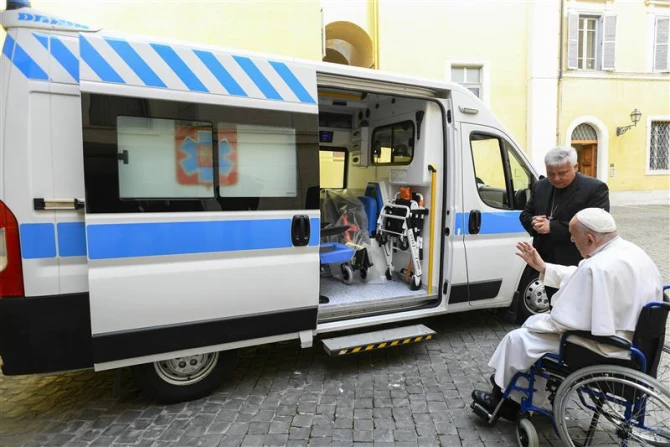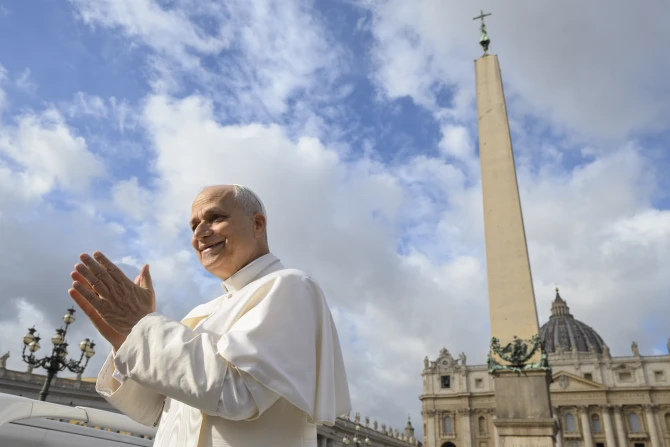On the opening day of the Synod on Synodality, a leading official of the process urged participants to read “the signs of the times” in order to “discover a grammar of synodality for our time.”
“Just like the grammar of our languages changes as they develop, so does the grammar of synodality: It changes with time,” said Cardinal Jean-Claude Hollerich, the relator general of the 16th Ordinary Assembly of the Synod of Bishops, in prepared remarks at the start of the afternoon session.
Discovering a new grammar of synodality, a term that means “journeying together,” may be the stated goal of the synod, which will continue throughout the month and conclude with a final assembly in October 2024. But on its opening day, synod leaders also highlighted the many ways in which the current gathering breaks the mold of past Synods of Bishops.
Cardinal Mario Grech noted that, for “the first time,” the inclusion of non-bishops in the synod, including “laymen and laywomen, religious men and women, deacons, and presbyters, who are no longer ‘exceptions to the norm,’ but full members of the assembly.”
Twenty-seven percent of the assembly’s 365 voting members are non-bishops, including 54 women. Eighty or so nonvoting members, including experts and facilitators, are also participating in the process.
“No delegation could ever adequately represent the totality of the people of God, the subject of the ‘sensus fidei,’” or sense of the faithful, said Grech, who heads the Vatican office that organizes the Synod of Bishops. He also added that the synod could not be considered a “full representation” of the Church, because it did not include the full participation of the college of bishops, like in an ecumenical council.
“But these sisters and brothers remind us by their very presence of the unity of the synodal process,” the Maltese prelate said.
The unique setting and layout of the Synod of Synodality — which is being held not in the Synod Hall but in the larger Paul VI Audience Hall — was also a focus of opening remarks.
Hollerich said the decision to have participants seated “not in hierarchical order” but at round tables to facilitate small-group discussion was not a decision made from the top down, but “mirrors the experience of the people of God” who participated in previous stages of the Synod on Synodality. That process began in 2021 and has included diocesan, national, and continental phases.
Even Pope Francis was seated at a round table, albeit at the head of the room and slightly elevated. The pope was joined at his table by key synod organizers, including Hollerich, Grech, synod undersecretary Sister Nathalie Becquart, and Patriarch Ibrahim Isaac Sidrak, the head of the Coptic Catholic Church and the president-delegate for the opening day.
Those who delivered opening remarks, including Pope Francis, did so while seated. Cameras at each table captured the image of those speaking, displaying them not only on a large screen at the front of the room but also on the four displays at each round table.
Hollerich added that “round tables also remind us that none of us is the star in this synod,” stating that the event’s “protagonist is the Holy Spirit.” The cardinal also suggested that bishops who “were not very active” in the preceding stages of the synod “may face challenges” with the layout, while many of the non-bishop members, in contrast, actively participated in the synod’s continental stage.
Synod organizers acknowledged that the process that had led to the present Synod on Synodality had not been without challenges.
Sidrak said that “at the beginning, it was not easy,” as many felt “a little disoriented” by the novelties of a multiyear synodal process that aimed for global participation. Grech also added that some whom he had encountered during earlier stages were “wary” of the process, and even said that his mother had recently asked him “why I ‘waste’ so much [time] in the secretariat offices if it doesn’t help me preach the Gospel.”
“She was right! And I don’t want to forget this question of hers even now that we are called to pause dynamically in prayer and listening for an entire month.”
However, synod leaders also said the proceeding stages of the synod legitimized the current assembly. Grech said that “the whole Church and everyone in the Church had the opportunity to participate in the synodal process,” while Sidrak added the synod assembly “was prepared by a consultation of the people of God, of each and every baptized person, each according to his or her own charism, in an even more vivid, real and concrete way.”
Hollerich said that the assembly’s task of discovering a contemporary grammar of synodality would “not start from scratch” but would be built upon the Church’s “rich theological tradition on synodality,” as well as the magisterium of the popes, especially Pope Francis.
The synod’s relator general also added that the process would be guided by “basic rules which never change”: baptismal dignity, the Petrine ministry, episcopal collegiality, ordained ministry, the common priesthood of the faithful, and “their interrelation.”
Hollerich also said that the synod’s “work of common discernment” should not be a parliamentary debate — “a battle between position A and B” and between so-called conservatives and so-called progressives — but “walking with Christ within his Church.”
With the opening day of the Synod on Synodality now complete, participants enter into a series of discussions and votes — with limited press access or media availability. Four “modules” will be devoted to the issues included in the Instrumentum Laboris, the document crafted based on the results of the previous synod stages, with a final session devoted to discussing and approving a final “synthesis report.”
Hollerich said his “heartfelt hope” is that the October 2023 assembly will develop a “road map” for the following year.
“Ideally this road map should indicate where we feel consensus has been reached among us and above all within the people of God, laying down the possible steps to undertake as a response to the voice of the Spirit,” he said. “But it should also say where deeper reflection is needed and what could help that process of reflection.”
This article was originally published on CNA.

